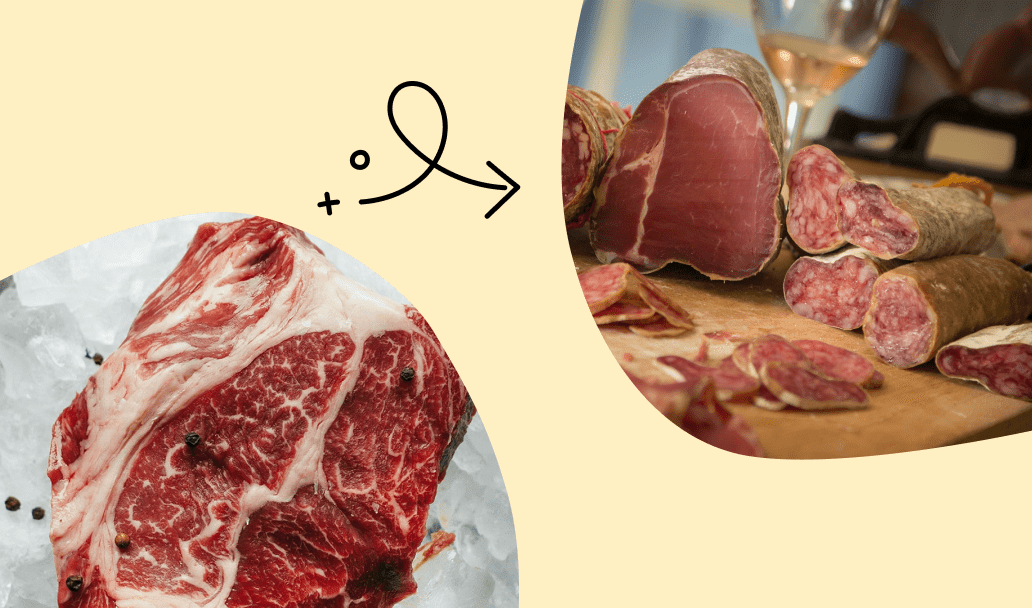You could have heard of salami as junk food. But, it happens that we still eat this product. Colleagues' birthdays at work and corporate parties - very often, the menu at such events includes red circles on pepperoni or simply on a plate. And we eat them because "a few pieces are ok." So, discuss if it is really "ok" to taste salami. 🤔
Consumers never know what might be hiding under a thin shell of fragrant salami. A quality product made according to all technological standards or a mess of fat, vegetable protein (soy, wheat), spices, and chemicals? Somehow, yes.
Eat tasty food and lose weight with Unimeal app!
Take a Quiz – Get personal meal plan – Achieve your weight goals!
Start QuizSalami is a meat product typically made from pork or beef, appropriately salted, smoked, "stuffed" with fat and spices, and kept in a room with special conditions (air temperature should be +15 C, and humidity - 60-70%). By the way, salting in salami has a double "mission." Salt helps the meat to ripen and kills harmful microorganisms. As the meat matures and dries, the consistency of this sausage becomes denser.

After about a month, it becomes moldy in a light green-gray hue and dries out significantly. The longer this sausage ripens, the darker its mold becomes, and the consistency becomes thicker. And it is considered ready in about three months.
Therefore, conscientious manufacturers recommend not saving on health and buying only expensive types of salami, the packaging of which indicates the composition of the sausage.
Salami has low carbs and calories but is high in protein, fat, and sodium1Oscar Mayer. (2019, January 4). Salami (hard). U.S. DEPARTMENT OF AGRICULTURE. Retrieved from https://fdc.nal.usda.gov/fdc-app.html#/food-details/172947/nutrients. It contains several other vitamins and minerals. These are vitamin B12, thiamine, niacin, and zinc. 100 grams of hard salami contain:

Salami is exceptionally high in sodium, with almost a quarter of your daily value in just three pieces. Although sodium plays a crucial role in regulating fluid balance, consuming high amounts can increase blood pressure, especially among those more sensitive to its effects2William B. Farquhar, PhD, et al. (2016 November 7). Dietary Sodium and Health: More Than Just Blood Pressure. J Am Coll Cardiol. DOI:10.1016/j.jacc.2014.12.039.

But even high-quality salami in uncontrolled portions is harmful to health. This sausage is quite fatty and high in cholesterol. Scientists have proven that salami can harm the digestive organs. So it is necessary to completely abandon its use for individuals complaining of poor digestion, pathologically poor liver conditions, and suffering from ulcers, pancreatitis, or gastritis7Susan Thapa, Lori A. Fischbach, et al. (2019, April 3). Association between Dietary Salt Intake and Progression in the Gastric Precancerous Process. Cancers (Basel). DOI:10.3390/cancers11040467.
In addition, salty and fatty meat accelerates the aging process of cells and helps the development of cardiovascular problems. Salt disrupts the acid-salt balance, increases blood pressure, and contributes to the accumulation of toxins in the body.
The International Agency for Research on Cancer recently classified processed meat as carcinogenic. Studies show that processed meat consumption may be associated with an increased risk of several types of cancer8Mitsumasa Umesawa, et al. (2016, February 5). Salty Food Preference and Intake and Risk of Gastric Cancer: The JACC Study. J Epidemiol. DOI:10.2188/jea.JE20150023. These are breast, colorectal, stomach, bladder, and esophageal cancers.

Surprisingly, salami is considered a good diet product, primarily if referring to the keto diet. Carb levels are deficient across most salami. The main rule is to stay away from the preservative-filled, sugar-loaded versions. Give a preference to going for salami made with natural processing and meats9Marco Cullere, et al. (2020, April 10). Fat Inclusion Level, NaCl Content and LAB Starter Cultures in the Manufacturing of Italian-Type Ostrich Salami: Weight Loss and Nutritional Traits. Foods. DOI:10.3390/foods9040476. And as always, check the labels!

To understand how often you can eat salami, consider several factors first. And better individual characteristics of the body. Remember that salami is high in sodium. So people with water retention and blood pressure issues should be careful. The American Heart Association recommends limiting sodium intake to less than 2,300 mg daily, or ideally less than 1,500 mg daily10Josephine E Prynn, Louis Banda, et al. (2018, June 30). Dietary sodium intake in urban and rural Malawi, and directions for future interventions. Am J Clin Nutr. DOI:10.1093/ajcn/nqy125. Approximately it is not more than 9 pieces.

Salami is a meat product usually made from pork or beef, fat, and spices that have been fermented and dried. Although it contains several essential nutrients, it's high in sodium and processed. Thus, you should always check the label and choose a low sodium variety whenever possible. And enjoy salami in moderate amounts as part of a balanced diet.
Unimeal does not diagnose or suggest treatments. Any description of the diet, training plan or supplement should be discussed with your current physician or nutritionist. This article does not address specific conditions and is simply meant to provide general information on healthcare topics. Following any advice is at your own initiative and does not impose any responsibility on the blog authors for your health and safety.
Sources:
By choosing high-quality sources, we make sure that all articles on the Unimeal blog are reliable and trustworthy. Learn more about our editorial processes.
1.
2.
3.
4.
5.
6.
7.
8.
9.
10.
Related Articles